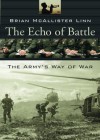The Echo of Battle: The Army’s Way of War
Written by: Brian McAllister Linn,
Harvard University Press, Cambridge, Massachusetts, 2007,
ISBN: 9780674034792, 312pp.
Reviewed by: Albert Palazzo
Professor Brian McAllister Linn, in The Echo of Battle: The Army’s Way of War, has done the US Army a great service. In a book of modest length he provides the institution with an outline of the origins and evolution of its intellectual tradition. This in itself would have been a major and important accomplishment but Linns book goes further to achieve operational relevance. This book will help current US Army soldiers understand the context of the way they fight, provide the means of deeper understanding, and highlight the opportunities for change.
Linn believes that the US Army possesses three intellectual traditions, which he identifies as ‘Guardians’, ‘Heroes’, and ‘Managers’. He uses these traditions as analytical tools to explain the US Army’s peacetime preparation for fighting future wars, and in the process demonstrates how their interaction underpins more than 200 years of US defence thought. While perhaps a simplification, Linn’s approach works, and it allows the reader to grasp a sweeping story of peacetime military innovation and adaptation.
From the perspective of contemporary operations The Echo of Battle’s examination of irregular warfare forms its most useful chapter. Linn shows that the force’s existing dichotomy of thought between conventional and unconventional warfare is long-standing and dates to the nineteenth century. He also demonstrates that the Army as a whole has never resolved this schism, although by default it tends to favour major war.
Although it is a breakthrough work, The Echo of Battle is not without its problems and Linn’s methodology will no doubt be questioned. In his loyalty to his interpretive mechanism Linn does not address a rather obvious question—why these three? Moreover, are they really unique to the US experience? At times his approach feels too pat, and other interpreters will certainly advance other constructs with regard to the US Army’s military thought.
If, as Linn maintains, the US Army uses peacetime to think about the future of war, he fails to give an adequate explanation for why its leaders then proceed to get it wrong so often, nor why there is an institutional tendency towards dishonesty of interpretation. Linn observes the repeated inability of officers to convert peacetime thinking into wartime anticipation, but leaves the reader puzzled as to why this occurs.
Linns research is impressive and he demonstrates a mastery of the literature and personalities of US thinkers. But the consequence of mentioning so many names, in such tantalisingly brief passages, is that he gives the impression that US Army’s intellectual traditions contain many disciples but no prophets. It is not clear if this was Linns intention, but his approach drives home the superficial nature of the forces intellectualism. This reviewer would have preferred a depth of analysis similar to that found in the works of Azar Gat on European military thought.
For the average reader The Echo of Battle will be a difficult work to appreciate. Linn bombards his audience with excerpts from a vast array of writings in order to constantly reinforce his theme. Its density and a certain leadenness of style will also limit its accessibility. For the Australian reader Linns effort highlights an important point—the need for a work on the ADFs intellectual tradition. Perhaps on a local level, The Echo of Battle’smost significant result will be to inspire a similar work for Australia.


